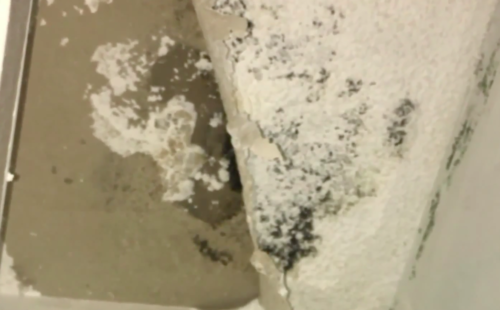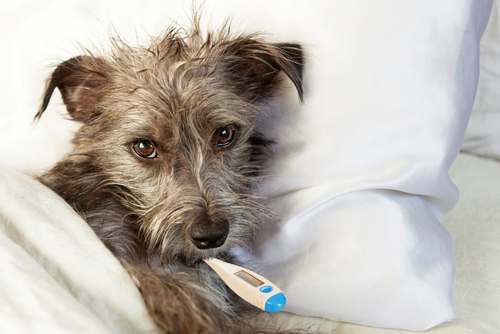We all know that mold and humans don’t mix well. No one should ever live in moldy conditions as they pose a major health risk. But can this fungus harm our dogs as well? A story out of Kansas City, Missouri, got us thinking about the harmful implications for our dogs. So, we decided to learn more about the dangers of mold and how they affect dogs.

One Dog’s Story
Lana Becerra and her dog discovered they both have an allergy after living in unpleasant conditions. Laura and her boyfriend rented an apartment in Kansas City. A few months after they moved in, they started noticing mold in their bedroom closet.
Apartment maintenance came and painted over the mold, assuring Laura it would not be a problem. However, mold kept growing.
Then, Laura and her dog got sick. After a trip to the ER, doctors told Laura she had a severe mold allergy. As a result of living with the fungus, Laura had an infection in her lungs and hives.
Unfortunately, Laura’s dog Bella was also impacted. Laura and her boyfriend brought Bella to the vet when she started losing large patches of fur.
Laura told Fox 4 KC, “From what we have talked to the vet, due to her having allergic reactions to having exposure to mold as well. She’s healing, now that we’re out of that apartment. She’s doing better.”
We are glad to hear Bella and Laura are doing better now that they moved out of the moldy apartment. But we couldn’t help but wonder what happens when dogs live with this fungus. So, we did some research.

What is Mold?
Let’s start with the basics. Mold is a type of fungus. It grows best in moist, warm environments. If you have a leak in your home, standing water is the perfect breeding ground for this fungus. It can grow in drywall, windows, indoors and outdoors.
Mold looks gross when it grows on a piece of bread or when you spot it in your home. However, the fungus plays an important role in our ecosystem. Mold helps in the breakdown of organic matter.
Not all mold is harmful, but some types have negative consequences for humans and animals.
Mold and Dogs Do Not Mix
According to Dr. Jennifer Coates, a veterinary advisor with petMD,
“Toxic mold is of particular concern for [dogs] because these organisms produce mycotoxins that can cause health problems.”
The five types of toxic mold are Cladosporium, Penicilium, Fusarium, Aspergillus, and Stachybotrys. They can cause annoying symptoms like a coughing fit or, worst-case scenario, neurologic problems, and death.
Symptoms of Mold Poisoning in Dogs
- Inhaled mold: Difficulty breathing, breathing more rapidly than normal, nasal discharge, excessive coughing, wheezing, sneezing, lack of energy, and, in some cases, bleeding from the mouth or nose.
- Ingested mold: Decreased appetite, vomiting, and changes to bowel movements.
- Allergic reaction: Scratching, chewing, licking or biting at itchy areas. These symptoms can lead to skin sores and fur loss.
If you observe any of these symptoms, take your pup to the veterinarian. Treatment for mold inhalation or consumption typically includes the management of respiratory symptoms, inducing vomiting, and IV fluids for dehydration if your dog suffers from gastric complications. Vets use medication to treat mold allergies.
Thankfully, if your dog interacts with the fungus, she will most likely fully recover if the source of mold is removed from her everyday life.
Preventing Pup Problems with Mold
Don’t allow mold to grow on places your dog likes to hang. So wash his bedding (especially if it becomes wet). Keep her food in a sealed container. Wash your dog’s food and water bowls regularly. Clean your dog’s toys.
If your dog likes to eat trash (did you toss those moldy leftovers in the garbage bin?) make sure it is out of reach and closed tightly. Watch your dog closely if his walks or outdoor activity take him near dumpsters.
Now, the tricky part. What about your home? If you notice a damp scent that reminds you of wet socks or rotten wood, you might have mold. Purchase a device to monitor levels of moisture. Check baseboards, windows, and drywall for moldy spots. A professional can help remove the growth.
If you spot mold, keep your dog and family members away from the area.
Good News, Bad News
First, the bad news: mold is harmful to humans and our dogs. It can trigger an allergic reaction or even worse. Now, the good news: as long as you remove the mold and your dog from the situation, your pup will most likely heal.
So, remember to be on the lookout and smell-out for mold.
If you want to see how one dog was impacted by an allergic reaction, watch Bella’s story below. Thankfully, once her mom and dad took her away from the fungus, the pup’s reaction went away and her fur grew back.


 Toledo, United States.
Toledo, United States.